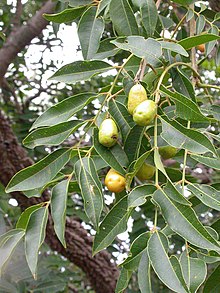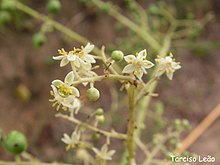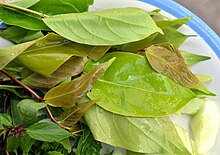Spondias mombin
| Spondias mombin | |
|---|---|

| |
| S. mombin, fruiting | |
| Scientific classification | |
| Kingdom: | Plantae |
| Clade: | Tracheophytes |
| Clade: | Angiosperms |
| Clade: | Eudicots |
| Clade: | Rosids |
| Order: | Sapindales |
| Family: | Anacardiaceae |
| Genus: | Spondias |
| Species: | S. mombin
|
| Binomial name | |
| Spondias mombin | |
| Synonyms[1] | |
| |
Spondias mombin, also known as yellow mombin or hog plum is a species of tree and flowering plant in the family Anacardiaceae. It is native to the tropical Americas, including the West Indies. The tree was introduced by the Portuguese in South Asia in the beginning of the 17th century. It has been naturalized in parts of Africa, India, Nepal, Bangladesh, Sri Lanka, The Bahamas, Indonesia, and other Caribbean islands. It is rarely cultivated except in parts of the Brazilian Northeast.
The mature fruit has a leathery skin and a thin layer of pulp. The seed has an oil content of 31.5%.[2]
Description





Spondias mombin is a small deciduous tree up to 20 m (66 ft) high and 1.5 m (4.9 ft) in girth, and is moderately buttressed.[3] Its bark is thick, corky, and deeply fissured. When slashed, it is pale pink, darkening rapidly. Branches are low and branchlets are glabrous. The leaves are pinnate, with 5-8 leaflets opposite pairs with a terminal leaflet, 10 cm × 5 cm (4 in × 2 in), oblong or oblong lanceolate, broadly acuminate, glabrous. The flowers bloom January to May and are sweet-scented, in large, lax terminal panicles of small white flowers. Fruits appear July to September and are nearly 4 cm (1.5 in) long, ovoid yellow, acid, wrinkled when dry. The fruits have a sharp, somewhat acid taste and are edible. Their flesh surrounds a single spiny kernel.
Use as food




The fruit pulp is either eaten fresh or made into juice, concentrate, jellies, and sherbets.
In Thailand this fruit is called makok (Template:Lang-th) and is used in som tam as a secondary ingredient. The young leaves, which taste slightly bitter and sour, are sometimes served raw together with certain types of nam phrik (Thai chili pastes). It is also served with chili powder in Bangladesh where the fruit is known as আমড়া (amṛa). In India, it is known as Amado in Konkani and omora in Assamese. In Nepal this fruit is called lapsi.
As a member of the sumac family (Anacardiaceae), exposure to the sap of this species may result in an identical allergic reaction to that of the poison ivy plant. Those with a known sensitivity to urushiol should exercise caution in consuming or handling this species.
Traditional medicine
In traditional medicine, Spondias mombin has had a variety of uses. The fruit has been used as a diuretic and febrifuge.[4] The bark is astringent and used as an emetic and for diarrhea, dysentery, hemorrhoids, gonorrhoea, and leukorrhea.[4] The flowers and leaves are used to make a tea for stomach ache, biliousness, urethritis, cystitis, and inflammation.[4]
Language
Spondias mombin has several common names. Throughout the Spanish-speaking Caribbean, except Cuba and the North of Mexico where it is called ciruela, in Nicaragua, Honduras, and in Mexico it is called jobo (derived from the Carib language[5]). In Costa Rica it is called yuplón after the English name gully plum. In El Salvador, it is called Jocote de Corona. Among the English-speaking Caribbean islands it is known as yellow mombin[6] or hog plum. In Jamaica it is also called Spanish plum, gully plum or coolie plum. In Surinam the fruit is called Mope. In Brazil, the fruit is known by several different names, such as cajá, taperebá and ambaló. In Peru, it is known as uvos or mango ciruelo. In Ghana, it is hog plum or Ashanti plum. It is called "Akukor" in the Ewe language of Ghana. In Bengali, it is called আমড়া (Amṛa). In the southern Indian state of Kerala it is called Ambazhanga അമ്പഴങ്ങ. In Kannada it is called AmateKaayi( ಅಮಟೆ ಕಾಯಿ ). In Goa it is known as ''Ambadde'. In Nigeria, the fruit is called Ughighen in the Urhobo language, Iyeye or Yeye in the Yoruba language,[7] ngulungwu in Igbo and isada in Hausa.[8] Other common names include hug plum, true yellow mombin, golden apple or Java plum, Ambaralla (ඇඹරැල්ල) in Sri Lanka. In Somalia, it is called Isbaandes. In Panama it is called jobo. In "habla congo" of palo mayombe in Cuba, it is called nkunia guenguere kunansieto', ciruela. In Palauan, it is called titimel. In Telugu, it is called neredupandu or neredukaya
See also
- List of plants of Cerrado vegetation of Brazil
- Amazonian cuisine
- Spondias purpurea (Purple mombin)
- Spondias tuberosa (Umbú)
- Spondias pinnata (India)
Notes
- ^ "Spondias mombin L." The Plant List: A Working List of All Plant Species. Retrieved June 27, 2014.
- ^ Eromosele, C.O; Paschal, N.H (2003). "Characterization and viscosity parameters of seed oils from wild plants". Bioresource Technology. 86 (2): 203–205. doi:10.1016/S0960-8524(02)00147-5. PMID 12653289.
- ^ "Hog plum". Encyclopedia Britannica. 2017-08-22. Retrieved 2021-03-19.
- ^ a b c Ayoka A.O, Akomolafe R.O, Akinsomisoye O.S & Ukponmwan O.E (2008). "Medicinal and Economic Value of Spondias mombin". African Journal of Biomedical Research. 11 (2): 129–136.
{{cite journal}}: CS1 maint: multiple names: authors list (link) - ^ Spanish Royal Academy Dictionary
- ^ NRCS. "Spondias mombin". PLANTS Database. United States Department of Agriculture (USDA). Retrieved 27 November 2015.
- ^ See Ayoka et al. (2008, p.130), Oladele (2008, p.5). Note that Aiyeloja & Ajewole (2006, p.57) give agbalumo as the local name in Osun State, however other sources identify agbalumo elsewhere in Nigeria with the African star apple, Chrysophyllum alibidum and related species; see for example Aiyeloja & Bello (2006, p.18) and Oyelade et al. (2005).
- ^ Aiyeloja, Adedapo Ayo; Bello, Oluwakemi A. (April 2006). "Ethnobotanical potentials of common herbs in Nigeria: A case study of Enugu state". Educational Research Review. 1 (1): 16–22.
References
- Oladele, O.I. (2008). "Contribution of Neglected and Underutilized Crops to Household food security and Health among Rural Dwellers in Oyo State, Nigeria" (PDF). Symposium Proceedings, online publication of presented papers. International Symposium "Underutilized plants for food, nutrition, income and sustainable development", Arusha, Tanzania 3–7 March 2008. Colombo, Sri Lanka: International Centre for Underutilised Crops (ICUC). Archived from the original (PDF) on 2016-03-14.
- Oyelade, O.J.; P.O. Odugbenro; A.O. Abioye; N.L. Raji (April 2005). "Some physical properties of African star apple (Chrysophyllum alibidum) seeds". Journal of Food Engineering. 67 (4). London: Elsevier Science: 435–440. doi:10.1016/j.jfoodeng.2004.05.046. OCLC 108380173.
- Adepoju, O.T.; O.E. Oyewole (2008). "Nutrient Composition and Acceptability Study of Fortified Jams from Spondias Mombin (Hog Plum, Iyeye in Yoruba) Fruit Pulp". Nigerian Journal of Nutritional Science. 29 (2): 180–189. ISSN 0189-0913.
- Tolu Odugbemi (2008). Outlines and Pictures of Medicinal Plants from Nigeria. University of Lagos Press. p. 119. ISBN 978-978-48712-7-3.
External links
- IUCN Red List least concern species
- Spondias
- Tropical fruit
- Trees of Central America
- Trees of the Caribbean
- Trees of North America
- Trees of South America
- Trees of Belize
- Trees of Costa Rica
- Trees of El Salvador
- Trees of Guatemala
- Trees of Nicaragua
- Trees of Panama
- Trees of Guyana
- Trees of Suriname
- Trees of Venezuela
- Trees of Brazil
- Trees of Bolivia
- Trees of Colombia
- Trees of Ecuador
- Trees of Peru
- Trees of Paraguay
- Trees of Mexico
- Flora of the Amazon
- Flora of the Cerrado
- Plants described in 1753
- Taxa named by Carl Linnaeus
- Plants used in traditional African medicine
- Medicinal plants of North America
- Medicinal plants of South America
- Fruit trees

